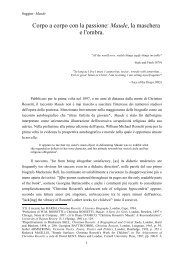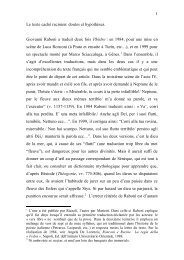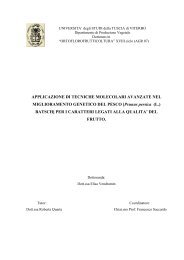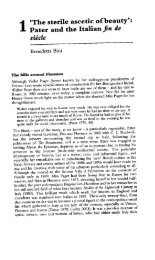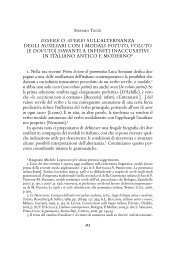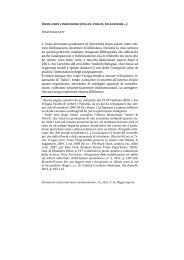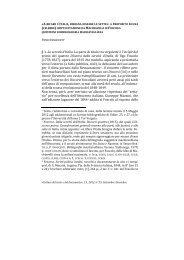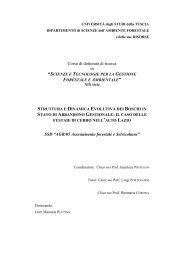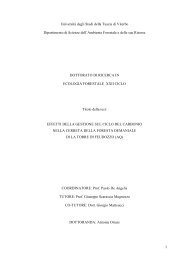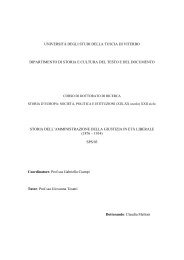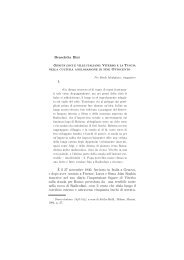drivers of soil respiration of root and microbial ... - Unitus DSpace
drivers of soil respiration of root and microbial ... - Unitus DSpace
drivers of soil respiration of root and microbial ... - Unitus DSpace
Create successful ePaper yourself
Turn your PDF publications into a flip-book with our unique Google optimized e-Paper software.
length could determine the range in which varies the delay between the photosynthetic C uptake <strong>and</strong><br />
its following <strong>respiration</strong>. Inside this limits the speed <strong>and</strong> the quantity <strong>of</strong> the translocated C to<br />
belowground is more likely determined by plant growing stage (Kuzyakov et al., 1999; Kuzyakov<br />
<strong>and</strong> Domanski, 2000; Gavrichkova <strong>and</strong> Kuzyakov, 2008; Carbone <strong>and</strong> Trumbore, 2007). The spped<br />
<strong>and</strong> quantity <strong>of</strong> C flow to <strong>root</strong>s will be regulated depending on the current size <strong>of</strong> <strong>root</strong>ing system, its<br />
growth rate, metabolic activity <strong>and</strong> relative contribution <strong>of</strong> fine <strong>and</strong> coarse <strong>root</strong>s to total<br />
belowground biomass (Dickson, 1991; Desrochers et al., 2002; Larionova et al., 2006; Carbone <strong>and</strong><br />
Trumbore, 2007) as well as by level <strong>of</strong> nutrients supply (Veen, 1981; Lambers et al., 1981; Kuiper<br />
1983; Gavrichkova <strong>and</strong> Kuzyakov, 2008).<br />
The effect <strong>of</strong> photosynthetic C supply on <strong>root</strong> <strong>respiration</strong> is <strong>of</strong>ten masked by temperature<br />
because <strong>root</strong> biomass typically peaks in summer (Lyr <strong>and</strong> H<strong>of</strong>fmann, 1967), however <strong>root</strong>s can<br />
only respire a proportion <strong>of</strong> what they are allocated, so the effect <strong>of</strong> temperature on <strong>root</strong> <strong>respiration</strong><br />
is likely to be constrained by GPP (Janssens et al. 2001). In fact, at Amplero, subjected to<br />
management based on the defoliation practices, the decrease in C supply from defoliated plants<br />
resulted in further decrease in correlation strength between temperature <strong>and</strong> <strong>root</strong>-derived<br />
<strong>respiration</strong>.<br />
The effect was less pronounced for total <strong>soil</strong> <strong>respiration</strong> as the <strong>root</strong> component account for a<br />
minor part <strong>of</strong> <strong>soil</strong> CO2 efflux at Amplero (av.30%, Fig. 3). Microbial <strong>respiration</strong> is more sensitive to<br />
changes in <strong>soil</strong> temperature <strong>and</strong> <strong>soil</strong> water content <strong>and</strong> more likely is independent <strong>of</strong> GPP, as in the<br />
<strong>soil</strong> there are large amounts <strong>of</strong> substrates waiting to be decomposed. Microbes however prefer the<br />
easily available C substrates, the quantity <strong>of</strong> which is determined by the litter input <strong>and</strong> <strong>root</strong><br />
rhizodeposition processes (Parton et al., 1987; Trumbore et al., 1990; Schimel et al., 1994; Schulze<br />
et al., 2000; Bahn et al., 2006), <strong>and</strong> thus indirectly or with a considerably higher time lags could<br />
be dependant on the site productivity.<br />
Temperature sensitivity <strong>of</strong> <strong>microbial</strong> <strong>respiration</strong> decreased from winter to summer (Table 2),<br />
which could be explained by physiological acclimation <strong>of</strong> <strong>soil</strong> microorganisms to high temperatures<br />
as well as by the increase in the <strong>microbial</strong> population in autumn period (Fig. 9). Similar seasonal<br />
changes were observed also by Luo et al (2001), Janssens <strong>and</strong> Pilegaard (2003) <strong>and</strong> Moyano et al.<br />
(2007). Increasing temperature in winter time could also activate dormant microbes <strong>and</strong> thus<br />
augment its C mineralization activity (Andrews et al., 2000), resulting in a sudden increase <strong>of</strong><br />
<strong>respiration</strong> rates. Andrews et al. (2000) reported a stronger temperature effect on <strong>microbial</strong><br />
population at lower temperatures. Low value <strong>of</strong> Q10 during the summer drought indicates as well a<br />
reduction in the diffusion rates <strong>of</strong> organic molecules <strong>and</strong> thus in microbes nutrient availability.<br />
Q10 <strong>of</strong> <strong>microbial</strong> derived <strong>respiration</strong> in the end <strong>of</strong> the growing season, was however un<br />
proportionally high than the overall one <strong>and</strong> the Q10 reported in literature (Schleser , 1982; Raich<br />
59




